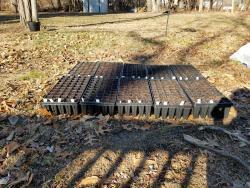lauriebasler said:Then when the whole area is tolerable, and maintainable, you can start to really implement your vision. Do this the same way, in small sections and baby steps, always stopping to keep the other areas in check.
Lakeside said:My property is already pretty wild, so I'm sort of moving in the opposite direction from where you are. However, I do have a fairly large area that the power company cleared and sprayed, which I'm trying to establish as a low maintenance, wildlife-friendly area. One thing I tried there, without success, was establishing a wildflower meadow. Turns out it's not as easy as it looks

I tried just scattering wildflower seeds over about a 1/4 acre. It looked okay, but sparse, the first spring. Then the grasses grew up and it looked pretty messy. The grasses took over the second year. This was a setback for me but not too big a deal because I live in a rural area without immediate neighbors to deal with. If you're in a residential area, you'll need to keep things somewhat maintained or you could end up with complaints, so a notice from the city that you need to cut things back.
After my initial meadow failure, I noted that there were some plants that had survived in with the grasses. I dug those up (mostly purple coneflowers and black-eyed susans) and concentrated them in one area. Over the past few years I've added more of those and I keep testing other plants to see what does well. When I find something that works, I add more of those to the mix and expand the planted area.
I've found that Rudbeckia "Goldstrum" is very popular with bees, butterflies, and birds; needs very little attention, reseeds, and will eventually spread and take over weedy areas. They work very well for me here in Tennessee. Not sure if they'd do as well in NJ.
I'm also experimenting with conifers in various locations. They're pretty tough and have wildlife benefits. Some spread and provide low maintenance ground cover, others have interesting shapes to provide structure to your garden.
lauriebasler said: Pick the spot you see the most, and make it acceptable to your eye, then maintain that, while moving on, in baby steps. Be patient. Others will see it as a beautiful improvements while you see it as a slow work in progress.
anna190 said:[quote="Invaded"]This question could fall under a few forums: Wild flowers, Native habitats, Gardening for wildlife, Gardening for Butterflies, Birds and Bees, or Landscape Design, but this forum seems to have some traffic so I'll ask here.
Hi,
I am new to the group so may not be doing this incorrectly.
I read 100 Plants for Bees, from the Xerces Society and got hooked on the idea of a pollinator garden.
When we move to Pensacola, FL there will be 5 acres that is all lawn, a wasteland for life. At any rate, for a best case result, they recommended 5000 sq. ft. for size, 1st year cover with clear green house plastic to begin to get rid of seeds and weeds. Then, start planting your seeds(pesticide free, local Native Plant Groups. )for the next growing season and continue from there. This is on pages 6 through 23. There are sections on trees and shrubs also. I'll start a little smaller, I think, and add more area over time.
There is a lot of other information in the book that relates to your thread and it can be purchased from the Xerces Society. Hope this helps you a little bit. It will be at least a year before I can start the process
of killing the seeds but I'll let you know progress. I would like to follow your progress, too, if you have the time. All the best, AMAH.


SkipNJ said:]
Still adding plants and entire areas of plants. I have a near 1000sq ft area cleared of grass that I'll be seeding and planting. I have several other "garden beds" that are planted full of stuff but I don't have pictures. 2021 will be awesome.